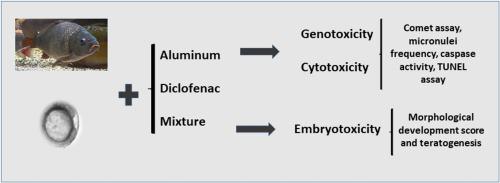Environmental Toxicology and Pharmacology ( IF 4.2 ) Pub Date : 2020-12-09 , DOI: 10.1016/j.etap.2020.103555 Eldher Hissadam Quiroga-Santos , Marcela Galar-Martínez , Sandra García-Medina , Eloy Gasca-Pérez , Selene Cano-Viveros , Karina Ruíz-Lara , Leobardo Manuel Gómez-Oliván , Hariz Islas-Flores

|
Several studies highlight the presence of aluminum and diclofenac in water bodies around the world and their ability to induce oxidative stress and a negative effect on biomolecules in several aquatic species. However, studies evaluating the toxic effect of mixtures of these contaminants are scarce. The objective of this work was to determine the genotoxic, cytotoxic and embryotoxic effect of the mixture of aluminum and diclofenac at environmentally relevant concentrations on Cyprinus carpio.
Juveniles of Cyprinus carpio were exposed to 0.31 μg L−1 of diclofenac, 24.45 mg L-1 of aluminum, and a mixture of both contaminants at the same concentrations for 12, 24, 48, 72 and 96 h. After the exposure time the liver, gills and blood were extracted and the following biomarkers were evaluated: micronucleus frequency, comet assay, caspase activity and TUNEL test. On the other hand, Cyprinus carpio embryos were exposed to diclofenac (0.31 μg L−1), aluminum (0.06 mg L−1) and their mixture at the same concentrations and exposure time. Microscopic observation was performed to evaluate embryonic development at 12, 24, 48, 72 and 96 h.
Diclofenac (0.31 μg L−1) induces significant increases in micronucleus frequency with respect to control (p < 0.05), in all tissues. Aluminum (24.45 mg L−1) significantly increases DNA damage index in liver and blood cells with respect to control (p < 0.05). All treatments increase caspases activity in all tissues with respect to control (p < 0.05). Diclofenac increases the percentage of TUNEL-positive cells in liver and blood; while aluminum and the mixture increases it significantly in gills and blood with respect to the control (p < 0.05). The mixture significantly delays embryonic development, while aluminum and the mixture significantly increase teratogenic index with respect to control (p < 0.05). In conclusion, exposure to environmental concentrations of aluminium, diclofenac and their mixture induces genotoxic damage, cell death by apoptosis and negative effects on the development of Cyprinus carpio and the toxic response is modified by the interaction of the xenobiotics.
中文翻译:

相关环境浓度的铝,双氯芬酸及其混合物对鲤鱼的生殖细胞毒性和先天畸形。互动研究
多项研究强调了世界各地水体中铝和双氯芬酸的存在及其诱导氧化应激的能力以及对几种水生物种中生物分子的负面影响。但是,缺乏评估这些污染物混合物的毒性作用的研究。这项工作的目的是确定环境相关浓度的铝和双氯芬酸混合物对鲤鱼的遗传毒性,细胞毒性和胚胎毒性作用。
将鲤鱼的少年暴露于0.31μgL -1的双氯芬酸,24.45 mg L -1的铝以及两种污染物的相同浓度混合物中,分别放置12、24、48、72和96小时。在暴露时间之后,提取肝脏、,和血液,并评估以下生物标记:微核频率,彗星测定,半胱天冬酶活性和TUNEL测试。另一方面,鲤鱼胚胎以相同的浓度和暴露时间暴露于双氯芬酸(0.31μgL -1),铝(0.06 mg L -1)及其混合物。在12、24、48、72和96 h进行显微镜观察以评估胚胎发育。
在所有组织中,双氯芬酸(0.31μgL -1)相对于对照(p <0.05)诱导微核频率显着增加。铝(24.45 mg L -1)相对于对照组显着增加肝脏和血细胞的DNA损伤指数(p <0.05)。相对于对照,所有治疗均增加了所有组织中的胱天蛋白酶活性(p <0.05)。双氯芬酸可增加肝脏和血液中TUNEL阳性细胞的百分比;铝和混合物在g和血液中的含量相对于对照显着增加(p <0.05)。混合物显着延迟胚胎发育,而铝和混合物相对于对照显着增加致畸指数(p<0.05)。总之,暴露于环境浓度的铝,双氯芬酸及其混合物会引起遗传毒性损害,细胞凋亡引起的细胞死亡以及对鲤鱼的发育的负面影响,并且异种生物的相互作用改变了毒性反应。











































 京公网安备 11010802027423号
京公网安备 11010802027423号